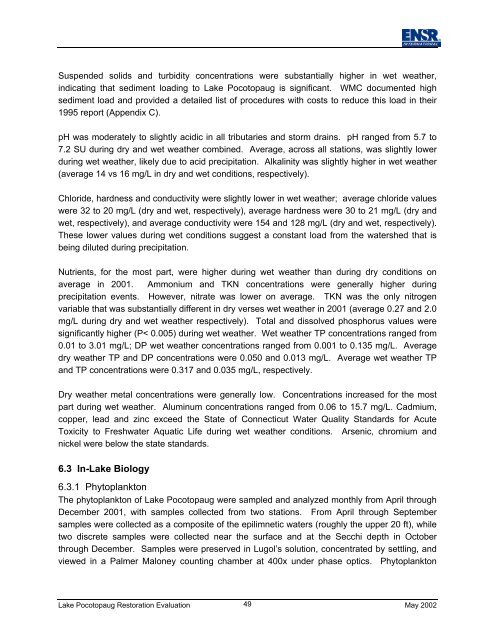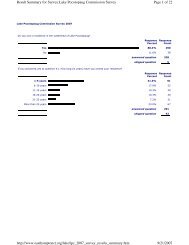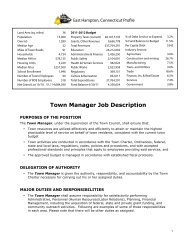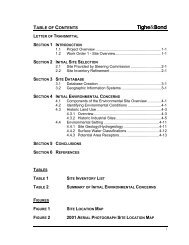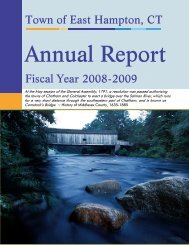Lake Pocotopaug Lake and Watershed Restoration Evaluation ...
Lake Pocotopaug Lake and Watershed Restoration Evaluation ...
Lake Pocotopaug Lake and Watershed Restoration Evaluation ...
Create successful ePaper yourself
Turn your PDF publications into a flip-book with our unique Google optimized e-Paper software.
Suspended solids <strong>and</strong> turbidity concentrations were substantially higher in wet weather,indicating that sediment loading to <strong>Lake</strong> <strong>Pocotopaug</strong> is significant. WMC documented highsediment load <strong>and</strong> provided a detailed list of procedures with costs to reduce this load in their1995 report (Appendix C).pH was moderately to slightly acidic in all tributaries <strong>and</strong> storm drains. pH ranged from 5.7 to7.2 SU during dry <strong>and</strong> wet weather combined. Average, across all stations, was slightly lowerduring wet weather, likely due to acid precipitation. Alkalinity was slightly higher in wet weather(average 14 vs 16 mg/L in dry <strong>and</strong> wet conditions, respectively).Chloride, hardness <strong>and</strong> conductivity were slightly lower in wet weather; average chloride valueswere 32 to 20 mg/L (dry <strong>and</strong> wet, respectively), average hardness were 30 to 21 mg/L (dry <strong>and</strong>wet, respectively), <strong>and</strong> average conductivity were 154 <strong>and</strong> 128 mg/L (dry <strong>and</strong> wet, respectively).These lower values during wet conditions suggest a constant load from the watershed that isbeing diluted during precipitation.Nutrients, for the most part, were higher during wet weather than during dry conditions onaverage in 2001. Ammonium <strong>and</strong> TKN concentrations were generally higher duringprecipitation events. However, nitrate was lower on average. TKN was the only nitrogenvariable that was substantially different in dry verses wet weather in 2001 (average 0.27 <strong>and</strong> 2.0mg/L during dry <strong>and</strong> wet weather respectively). Total <strong>and</strong> dissolved phosphorus values weresignificantly higher (P< 0.005) during wet weather. Wet weather TP concentrations ranged from0.01 to 3.01 mg/L; DP wet weather concentrations ranged from 0.001 to 0.135 mg/L. Averagedry weather TP <strong>and</strong> DP concentrations were 0.050 <strong>and</strong> 0.013 mg/L. Average wet weather TP<strong>and</strong> TP concentrations were 0.317 <strong>and</strong> 0.035 mg/L, respectively.Dry weather metal concentrations were generally low. Concentrations increased for the mostpart during wet weather. Aluminum concentrations ranged from 0.06 to 15.7 mg/L. Cadmium,copper, lead <strong>and</strong> zinc exceed the State of Connecticut Water Quality St<strong>and</strong>ards for AcuteToxicity to Freshwater Aquatic Life during wet weather conditions. Arsenic, chromium <strong>and</strong>nickel were below the state st<strong>and</strong>ards.6.3 In-<strong>Lake</strong> Biology6.3.1 PhytoplanktonThe phytoplankton of <strong>Lake</strong> <strong>Pocotopaug</strong> were sampled <strong>and</strong> analyzed monthly from April throughDecember 2001, with samples collected from two stations. From April through Septembersamples were collected as a composite of the epilimnetic waters (roughly the upper 20 ft), whiletwo discrete samples were collected near the surface <strong>and</strong> at the Secchi depth in Octoberthrough December. Samples were preserved in Lugol’s solution, concentrated by settling, <strong>and</strong>viewed in a Palmer Maloney counting chamber at 400x under phase optics. Phytoplankton<strong>Lake</strong> <strong>Pocotopaug</strong> <strong>Restoration</strong> <strong>Evaluation</strong> 49May 2002


